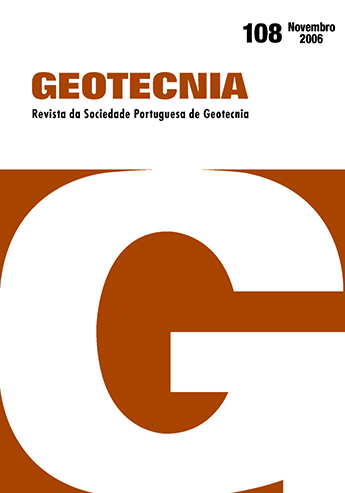Evaluation of static liquefaction potential of mining tailings
DOI:
https://doi.org/10.14195/2184-8394_108_9Keywords:
Liquefaction, Lab tests, Mining tailingsAbstract
The liquefaction process is strictly related to the abrupt loss of shear strength of loose, saturated and coarse grains. It is induced by a significant decrease in the effective stress and the consequent increase in pore pressure, which, in turn, can be related to vibration, seismic events and the use of explosives. Liquefaction may also be present in non seismic regions, as the case of the Quadrilátero Ferrífero, in the state of Minas Gerais, Brazil, due to static loading. In this work iron ore tailings were investigated for their susceptibility to liquefaction. For that, tailings samples were collected in six different tailings containment systems of the Quadrilátero Ferrífero, followed by an extensive laboratory program. Many series of triaxial tests under undrained conditions were performed in isotropically consolidated samples. The results of these tests are presented in this work, showing that the occurrence of liquefaction is a possibility for iron ore tailings, corroborating also the methods used for evaluating this phenomenon.
Downloads
References
Bishop, A.W. Progressive failure - with special reference to the mechanism causing it. In: Geote - chni cal Conference on Shear Strength Properties of Natural Soils and Rocks. 1967, Oslo. Proceedings... Oslo, 1967. v. 2, p. 142-150.
Castro, G. Liquefaction of sands. Cambridge: Harvard University, 1969. 231 p. Thesis of Doctor of Philosophy, Harvard University, Cambridge, Massachusetts, USA, 1969.
Fourie, A.B., Blight, G.E. & Papageorgiou, G. Static liquefaction as a possible explanation for Merriespruit tailings dam failure. Canadian Geotechnical Journal, Canada, v. 38, p. 707-719, 2001.
Gomes, R.C., Oliveira Filho, W.L. & Ribeiro, L.F.M. Laudo pericial da ruptura do dique de con - ten ção de rejeitos de minério de ferro da Cava C1 da Mineração Rio Verde Ltda., localizada no mu nicípio de Nova Lima / MG. Min. Público de Minas Gerais, 2001. 22 p.
Gomes, R.C., Pereira, E.L., Ribeiro, L.F.M. & Silva, J.T.G. Evaluation of liquefaction potential of fine grained tailings. In: International Congress on Environmental Geotechnics, ICEG, 4. 2002, Rio de Janeiro. Proceedings, Lisse, Netherlands: Swets & Zeitlinger, 2002. v. 1, p. 329-333.
Head, K.H.. Manual of soil laboratory testing. London, UK: Pentech Press, 1986. 1240 p.
Ishihara, K., Tsukamoto, Y., & Shibayama, T. Evaluation of slope stability against flow in saturated sand deposits. Jubilee volume of Terzaghi, 2000.
Lambe, T.W. Methods of estimating settlement. In: Conference on Settlement, ASCE. 1964, North - wes tern University, Evanston, IL. Proceedings, Evanston, 1964.
Pereira, E.L. Estudo do potencial de liquefação de rejeitos de minério de ferro sob carregamento estático. Ouro Preto: UFOP, 2005. 186 p. Dissertação (Mestrado), Programa de Pós-graduação em Engenharia Civil, Escola de Minas, Universidade Federal de Ouro Preto, Ouro Preto, 2005.
Poulos, S.J., Castro, G. & France, J.W. Liquefaction evaluation procedure. Journal of Geotechnical Engineering Division, ASCE, v. 111, n. 6, p. 772-792, 1985.
Sladen, J.A., D’Hollander, R.D. & Krahn, J. The liquefaction of sands, a collapse surface approach. Canadian Geotechnical Journal, v. 22, p. 564-578, 1985.
Tibana, S., Campos, T.M.P. & Bernardes, G.P. Behaviour of a loose iron tailing material under triaxial monotonic loading. In: International Congress on Environmental Geotechnics, ICEG, 3. 1997, Lisbon, PT. Proceedings, Lisbon, 1998. CD-ROM.




